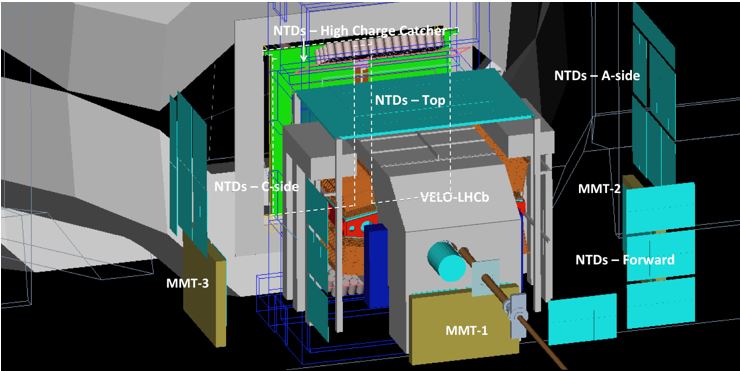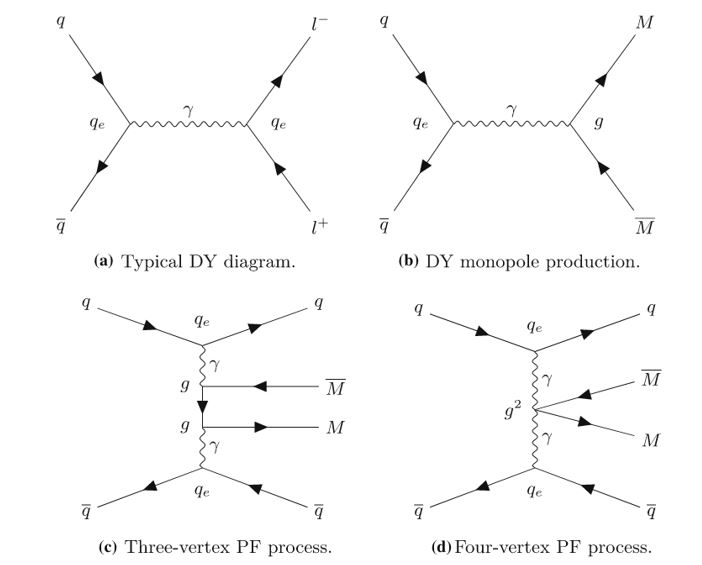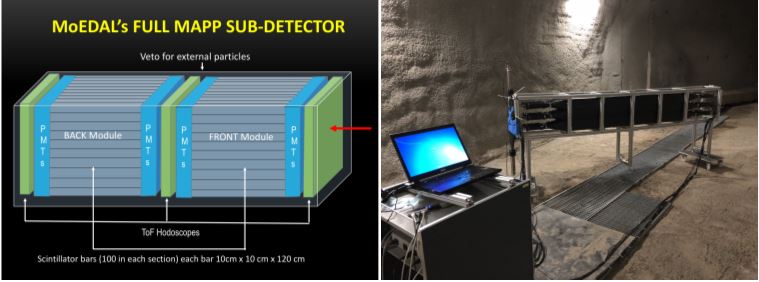The MoEDAL Experiment at the Discovery Frontier
MoEDAL, the LHC’s newest experiment [1], that started official data taking in 2015, is different to other collider detectors. It is currently comprised of passive tracking, using plastic Nuclear Track Detectors (NTDs) and trapping sub-detectors that are capable of retaining a permanent direct record of discovery and even capturing new particles for further study in the laboratory. It also has a small TimePix pixel device array for monitoring beam-related backgrounds. MoEDAL is designed to only detect anomalously ionizing avatars of new physics and is insensitive to Standard Model physics signals. Thus, it can to operate without an electronic trigger. A full GEANT4 model of MoEDAL is now available. A visualization of this model is shown in Figure 1.
Figure 1. A visualization of the Geant4 simulation of the MoEDAL experiment, represented using Geant4's PANORAMIX.
One of the primary aims of the General Purpose LHC Detectors (GPDs), ATLAS and CMS, was to discover the Higgs boson and study its properties as precisely as possible. As we all know the discovery a new particle by ATLAS and CMS, which is now largely identified with the Standard Model Higgs boson, was announced in 2012 [2]. In a similar way the main aim of the MoEDAL experiment is to search for the Magnetic Monopole. The main modern conception of the magnetic monopole is that it is a topological “excitation” in the Higgs field of the underlying theory. In this way the main physics aims of the GPDs and MoEDAL are complementary. Their experimental sensitivity is also complementary in that GPDs have limited sensitivity to Highly Ionizing Particles (HIPs), which MoEDAL is designed to detect. On the other hand MoEDAL cannot detect the decays of new particles into Standard Model states.
MoEDAL published its first physics result based on data taken with the prototype trapping detector in 2016 [3]. In this case the characteristic magnetic field of a monopole captured in the trapping detector was sought using the SQUID magnetometer facility at ETH Zurich. A null result allowed MoEDAL to place the world’s best limits on magnetic monopoles with multiple (Dirac) charge (gD). Our first result using data taken during LHC’s Run-2 was published in 2017 [4] and a result with higher luminosity came out in 2018 [5]. In this paper we presented experimental limits on the direct search for spin-1 monopoles for the first time. The Run-2 data allowed MoEDAL to improve the mass limit for spin-1/2 monopoles to as much as roughly 1.6 TeV. Also, the limit on multiply charged monopoles was pushed to 5gD. A summary of MoEDAL results compared to those obtained by the ATLAS and CDF experiments is shown in Figure 2.
Figure 2. A comparison of the mass versus magnetic charge limits achieved at the Tevatron and the LHC.
Another unique feature of the MoEDAL experiment is the level of fruitful cooperation between experimentalists and theoreticians. One example of this partnership is a paper published in 2018 [6] by MoEDAL authors, where the phenomenology of photon-fusion and DY production of spin 0, ½, 1 monopoles was studied in detail - for the cases where the monopole coupling is velocity-dependent or velocity-independent. Duality arguments were used to justify an effective monopole-velocity-dependent charge in the monopole-matter scattering processes. A magnetic-moment term proportional to a new parameter κ is added to the effective theory to enrich the monopole phenomenology describing the interactions of monopoles with photons. As we lack a fundamental microscopic theory of magnetic poles, such an addition appears reasonable. This creates a dependence of the scattering amplitudes of processes on this parameter. The κ parameter is proposed as a tool for monopole searches which can be tuned to explore different models.
Figure 3. Feynman-like tree-level diagrams for production processes of a monopole pairs via a Drell-Yan –Yan process (b) and monopole-antimonopole pair production via photon fusion (c) & (d).
We are now poised to publish result on the search for monopoles produced via photon fusion as well as the Drell-Yan mechanism, informed by the above-mentioned phenomenological work. The Feynman diagrams describing these processes are shown in Figure 3. In addition, we are completing the search for highly electrically charged particles during LHC’s Run-1, the first result that utilizes MoEDAL’s NTDs. This is another arena where we expect MoEDAL to be extremely competitive with other collider limits. The delay in producing this first NTD result was due to the need to formulate our own custom alcohol “cocktail”, which we add to our etchant to improve the visibility of the etch pits. This was necessary since the commercial product that we used formerly is no longer available. Actually, we eventually discovered a mix that gives even better results than the original. Now MoEDAL’s NTD sub-detector is truly in business.
Late in 2017, we installed a prototype of a new sub-detector called MAPP (MoEDAL Apparatus for Penetrating Particles) in the UGC1 gallery in the LHCb/MoEDAL cavern. This gallery runs diagonally away from the main LHC tunnel, in the plane of the machine, as shown in Figure 4. The MAPP detector can be anything from 30 m to 55 m distant from the intersection point (IP8). The size of the gallery is such that it is always possible to have a 6 m-10 m decay zone in front of MAPP wherever it is placed along the gallery. The intervening rock serves to shield the detector from Standard Model backgrounds originating from IP8. The high-energy muons that do penetrate can be used to calibrate the detector.
Figure 4. The MoEDAL MAPP sub-detector deployed in the UGC1 gallery in the vicinity of IP8.
The aim of the MAPP sub-detector is to extend the discovery reach of the MoEDAL experiment to include mini-charged particles and new long-lived neutral particles. We feel this is in keeping with MoEDAL’s philosophy of expanding the physics reach of the LHC, in scenarios where the GPDs have significantly reduced sensitivity. We envisage that the full MAPP detector, will be comprised of two sections each of 100 (10 cm x 10 cm x 120 cm) scintillator bars readout out at each end by Photomultiplier Tubes (PMTs) forming a “double-decker” sandwich with three ToF hodoscope planes as the “bread”, as shown if Figure 5 (left). The purpose of the 2.4 m total length of scintillator is to enhance the signal with fractional charge as low as 0.001e, where e is the electron charge. The function of the decay zone in front of MAPP is to enhance its ability to detect decays in flight. A photograph of the 1/10th size prototype of the first compartment of the proposed MAPP detector, deployed in the UGC1 gallery, is shown in Figure 5 (right).
Figure 5. (Left) A sketch of the proposed MAPP sub-detector. (Right) A photograph of the MAPP prototype deployed in the UGC1 gallery.
The MoEDAL Collaboration is now preparing a request to take data during LHC’s Run-3, to pursue the search for highly ionizing messengers of physics beyond the Standard Model to 14 TeV, using the 30 fb-1 of luminosity that is expected to be available at IP8 over that period. During the LHCs imminent shutdown (LS2) we will also complete the analysis of all of the data we took during Run-2, with the full detector. Additionally, we will utilize this respite in LHC running to deploy and test the new MAPP sub-detector the purpose of which will be to search for fractionally charged particles and new long-lived neutrals. Paradoxically, the LS2 shutdown will mark an exciting period of intense activity for MoEDAL, the LHC’s newest experiment.
References
[1] J. L. Pinfold et al., “Technical Design Report of the MoEDAL Experiment, MoEDAL Collaboration. Jun 8, 2009. 76 pp. CERN-LHCC-2009-006, MoEDAL-TDR-001.
[2] A. Cho, “The Discovery of the Higgs Boson”, Science 21 Dec 2012: Vol. 338, Issue 6114, pp. 1524-1525, DOI: 10.1126/science.338.6114.1524.
[3] B. Acharya et al., The MoEDAL Collaboration, “Search for magnetic monopoles with the MoEDAL prototype trapping detector in 8 TeV proton-proton collisions at the LHC”, JHEP 1608 (2016) 067.
[4] B. Acharya et al., the MoEDAL Collaboration. “Search for Magnetic Monopoles with the MoEDAL Forward Trapping Detector in 13 TeV Proton-Proton Collisions at the LHC”, Phys. Rev. Lett. 118 (2017) no.6, 061801.
[5] B. Acharya et al., the MoEDAL Collaboration, “Search for magnetic monopoles with the MoEDAL forward trapping detector in 2.11 fb−1 of 13 TeV proton-proton collisions at the LHC”, Phys. Lett. B782 (2018) 510-516.
[6] S. Baines, N. E. Mavromatos, V. A. Mitsou, J. L. Pinfold and A. Santra, “Monopole production via photon fusion and Drell–Yan processes: MadGraph implementation and perturbativity via velocity-dependent coupling and magnetic moment as novel features”, Eur. Phys. J. C (2018) 78: 966.





